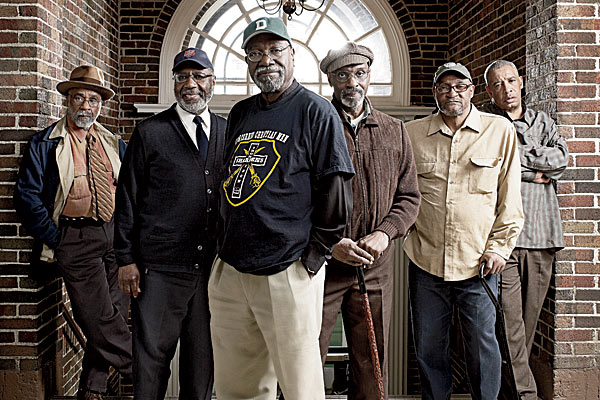
Alums of Dartmouth’s Foundation Years project: (from left) C. Siddha Webber, Percy Wiggins, Allan “Tiny” Evans, Henry Jordan, Henry Crumpton, and Cecil Davis
Related:
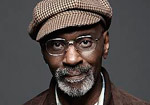
PHOTO GALLERY »
Meet the students from the street
In 1967, a young adman living in Chicago paid a visit to his alma mater, Dartmouth College, to discuss an idea that seemed preposterous at the time. He wanted to take poor African American kids from the streets of North Lawndale, Chicago’s roughest neighborhood, and enroll them at the Ivy League institution in small-town Hanover, New Hampshire. DeWitt Beall, class of ’62, said he had candidates in mind. He had met them while shooting a film on the West Side. He insisted they could make it at Dartmouth and deserved the chance.
Charles Dey, the powerful Dartmouth associate dean, was listening. Deeply committed to public service, Dey was among many educators seeking qualified black students to integrate their campuses. But finding such students and uprooting them to study in an all-white world had been exceedingly difficult; Dartmouth’s minority enrollment, like that at most mainstream institutions in the United States, was minuscule.
Beall argued that these kids from North Lawndale had raw native intelligence. Their academic preparation was definitely not up to Dartmouth standards, but they were street-smart and were excellent public speakers. And, oh yes, they were Vice Lords, which was, and remains, one of the biggest and most notorious street gangs in Chicago.
Dey was still interested. “My feeling was that we could admit people who had demonstrated ability in other areas of life,” he recalled in a recent interview. So the dean took the proposal to the college president, John Sloan Dickey, a staunch advocate of social justice, who had been on President Truman’s Committee on Civil Rights. Dickey agreed that Beall’s proposal represented a worthy experiment, and the first two students arrived from North Lawndale in the fall of 1967.
This program that transported gang members from Chicago to Dartmouth was called the Foundation Years and ran from 1967 to 1973. It was organized to enroll students for two probationary years; with acceptable achievement, they could then continue toward a degree, possibly in two additional years.
It was not, by most metrics, a roaring success. Fifteen men were admitted. Seven graduated with bachelor’s degrees; eight dropped out. Almost all of them returned to Chicago, most to the city’s segregated neighborhoods, where half beat the odds and found productive careers. The other half did not, and six of them died in the inner city’s clutch of drugs and guns, a plague that was becoming lethal just as these men were going east to school.
The program was instigated with the hope, perhaps naive, that astonishing Horatio Alger stories would spring from Chicago’s ghetto. That did not happen. Nor did gangs become the obvious key to integrating Dartmouth, which has since grown sophisticated at achieving diversity. (Among the 4,248 undergraduates last fall, 42 percent were students of color or “unknown” ethnicity.)
The Foundation Years story, instead, is one of culture clash—of two starkly different sides of a society in the throes of the civil rights movement. It highlighted race relations, in that highly charged time, in sometimes comic, sometimes tragic, and almost always poignant ways.
Still, while the Foundation Years didn’t change the world, it influenced almost everyone it touched. “These guys embodied the kinds of changes that we needed to make at Dartmouth,” says Paul Rahmeier, then the chaplain and the associate dean of the Tucker Foundation, the college’s center for community and social services programs. Rahmeier, adviser and confidant to the Foundation Years students, regarded them as one of the several positive changes on campus at the time: A broader faculty with degrees from other prestigious universities improved academics. Women were admitted to the school in 1972. “And we needed to have students on campus with street experience,” he says.
Dartmouth was an obvious turning point for the students, too. C. Siddha Webber, who entered the program in 1969 and graduated in 1972, says he didn’t initially want to leave the streets and go to Dartmouth. “I didn’t trust the environment,” he says. But he went anyway, and it worked out. “I had never been around intellectual white people before. It transformed me.”
Photograph: Jeff Sciortino
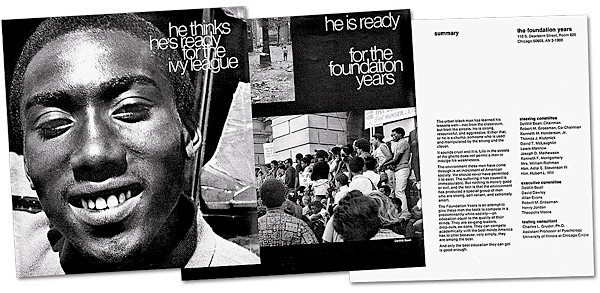
Pages from the Foundation Years 1968 promotional catalog
Related:

PHOTO GALLERY »
Meet the students from the street
Last year, I came across this Dartmouth–Vice Lords connection quite by accident while researching a story about historic graystones in North Lawndale. A real-estate lawyer with the Legal Assistance Foundation mentioned that he had been startled over the years by a few clients, relatively down-and-out by the time they got to him, who said they had gone to Dartmouth. He always wondered how the sons of North Lawndale had made it to the college of Daniel Webster and Nelson Rockefeller. He thought I should check it out.
But information was hard to find. At Dartmouth, few people remember anything of the Foundation Years—not in the administration, not in the university archives. It’s forgotten in North Lawndale, too, which is still poor and where gangs have become, if anything, more insidious than they were in the 1960s. But the subject remained fixed in my mind, and I eventually ran across an old Dartmouth brochure about the program that listed the name of Allan “Tiny” Evans as one of its early students. A local directory had a phone number for an Allan T. Evans. “That’s me,” said the voice that answered my call when I haltingly described my quest. You could say the dam broke loose with Evans, who soon volunteered himself as my “key informant” (he majored in sociology). Today, he lives in Englewood, retired from Chicago Public Schools. He’s personable, insightful, and smart—and probably one of the most unlikely members of Dartmouth’s class of ’71.
Dartmouth was founded in 1769, largely as a mission to “civilize and Christianize” Native Americans, in the New England wilderness, as Charles Dey, now retired, describes it. In fact, the college never admitted many Native Americans—rather it became the last institution of higher education founded under colonial rule and is now the nation’s ninth oldest. Among Ivy League schools, it is arguably the most lovely, with Georgian architecture around manicured greens, and it is definitely the most remote. It is also eminent for its social awareness—partly because the Tucker Foundation encourages activism and, some say, because its very isolation inspires a liberal spirit. Dartmouth has always had a disproportionate number of Peace Corps volunteers compared with other colleges. It pioneered Outward Bound. Not liberal, but also well known, the polemical Dartmouth Review enjoys a national reputation for ex-editors who go on to write for stridently conservative publications. In any case, Dartmouth has long prevailed against provincialism.
As for civil rights, the school’s history reaches back to the spring of 1967, when George Wallace, the segregationist former governor of Alabama, was invited to speak. The campus had only 20 or so blacks at the time, out of an enrollment of 3,200. But Wallace was interrupted by student hecklers who hated his separate-but-equal message. As he left the campus, his car was swarmed by angry white males.
Dartmouth’s first known contact with North Lawndale also came in 1967, when a white graduate named David Dawley, class of ’63, got a job researching the attitudes of inner-city youth about federally funded summer programs.
Through this work, he became friends with high-ranking members of the Vice Lords, the area’s most powerful gang, who used persuasion and occasional violence to expand their influence throughout the West Side. No one had illusions about government performing miracles in the neighborhood, but Dawley learned that “Vice Lord leaders wanted a change from the traditional dead-end street warfare,” as he later wrote in his book, A Nation of Lords, first published in 1973.
“We were communicating with politicians and trying to change conditions in the community. And we were opening up avenues for people to get some education,” says Bobby Gore, who was the Vice Lords’ spokesman before he went to jail in 1969 on charges that he insists were trumped up by authorities who distrusted black power of any kind.
Dawley was a deliberate catalyst in this piece of Vice Lords history. He had served in the Peace Corps after college, then moved to North Lawndale in 1967 and worked with the Vice Lords for two years. As he acquired their trust, he also secured grants from the Rockefeller Foundation and others to start legitimate businesses under an umbrella organization called CVL, for Conservative Vice Lords, a variant name for the gang. The experiment was successful for several years, later falling apart for many reasons—hard drugs topping the list.
DeWitt Beall was one year ahead of Dawley at Dartmouth. He came to Chicago to work in advertising, finding success as a filmmaker at Reach, McClinton & Co. Like many young men his age, Beall was inspired by the possibility of change and wrangled a client, American Can Company, to fund a documentary about the West Side. After Dawley blazed the trail, Beall found his way to North Lawndale, and in 1969 he completed Making It, a film about African Americans and the difficulties of transitioning from welfare to work.
Among Beall’s contacts in the neighborhood were Henry Jordan, a high-ranking Vice Lord, and Tiny Evans, a member of the Braves (a West Side gang later absorbed by the Vice Lords). Beall was particularly fascinated by these young men, who were just a year or two younger than he was but appeared to have mastered street life as respected gang elders, savvy politicians, and all-around hustlers. (Beall made a second documentary, Lord Thing, about the Vice Lords as a political-social movement; it screened at the 1970 Venice Film Festival.) He was impressed by their intelligence and ambition, and he couldn’t help but notice that they were getting $150 a week to attend Central YMCA Community College as part of a federal work-study program. Why not Dartmouth?
When Dean Dey told Beall that the school would admit the gang members, it was with the caveat that money had to be raised for their scholarships. Beall networked his Dartmouth connections and met the attorney Robert Grossman (Dartmouth, ’56), of the blue-blooded firm of Keck, Mahin & Cate. A liberal who believed deeply in affirmative action, Grossman introduced Beall to another attorney, Ken Montgomery (Dartmouth, ’25), a partner at Wilson & McIlvaine, who was heir to the C. W. Post cereal fortune and had an activist bent. He was as fascinated by gang life as Beall was.
Beall and Grossman asked Montgomery for $5,000 to fund two scholarships. “It was a time when everyone was making an effort to open doors for blacks,” Grossman says. “One of the delusions we had was that if we simply put these kids in the world we came from, they would succeed, or at least progress.” Montgomery offered them $10,000.
* * *
Photograph: Courtesy of Dartmouth College
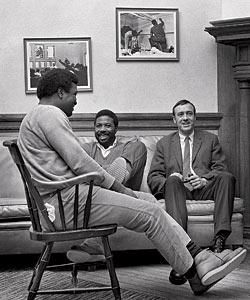
Evans, Wiggins, and Dartmouth associate dean Rahmeier circa 1968
Evans and Jordan flew to Lebanon, New Hampshire, the closest airport to Hanover, in September 1967. They were met by members of Dartmouth’s tiny Afro-American Society, including Woody Lee, class of ’68, and Bill McCurine, class of ’69, who were, by their own description, middle-class blacks who had done well in high school. In fact, they were brilliant. Lee, from New Jersey, went on to become a cardiologist at the Yale School of Medicine. McCurine, from Chicago (he grew up in Lake Meadows and went to Francis Parker), was a Rhodes scholar, went to Harvard Law School, and now sits as a federal magistrate judge in San Diego.
Dean Dey had asked the students to pick up the newcomers. No discussion was needed about how they would recognize one another at the small airport. But everyone did double takes when they met. Lee and McCurine were sporting faded blue jeans, beat-up loafers, and big Afros. Evans and Jordan, on the other hand, had been sent to Brooks Brothers before going east. Evans, a good six feet and weighing more than 200 pounds, wore a crisp three-piece suit. Jordan was muscular and looked good in a blue blazer and gray flannels. “They looked like they had just stepped out of GQ,” McCurine recalls.
Related:

PHOTO GALLERY »
Meet the students from the street
Evans and Jordan roomed with Lee that year in Lee’s dorm, the home of the senior honor society Casque and Gauntlet. Members occasionally performed secret medieval rites that bespoke privilege of membership; to Evans and Jordan this was just another strange Ivy League custom. But they went with the flow. To make their room resemble others in the dorm, they lined their shelves with books. They smoked more weed at Dartmouth than they ever did in Chicago. “And their dress quickly adapted to the Dartmouth norm at the time,” Lee recalls.
On the other side, Dartmouth was openly mystified by these new freshmen. Robert Havens, a white student who lived in the dorm, remembers their room as dark and “like a kind of den,” with the sounds of James Brown and a black crooner named Arthur Prysock on the stereo. (“Your dress lies against the cheek and the hollow of your thighs like running water,” went a Prysock lyric. At an all-male school, Havens was impressed.)
Evans was also a jokester. “I saw that as a wonderful coping mechanism,” says Havens, who sometimes didn’t know what to make of it. When he suggested one time to Evans that they go for a swim in the college pool, Evans said no. “Don’t you know, Bob? Negroes don’t float.” Evans’s good humor forged a friendship—which was tested when Evans and Jordan totaled Havens’s car a few months later.
Evans and Jordan made an even deeper impression on Woody Lee, who was a senior but two or three years younger than these special freshmen. Lee remembers stories told late into the night about their exploits as Vice Lords. “It was like they were living in a kingdom where everything came to them, where all the riches, all the glory, and the money came to them.” Lee says that the details were sometimes vague, but that was part of the mystique.
Happily, Evans and Jordan did well enough in their first year for Dartmouth to expand the Foundation Years program. Again, the problem was to identify qualified students, and that was left largely to Evans, Jordan, and Beall (who died in 2006). Five entered the next year, all friends from the streets, and two of them had been Evans and Jordan’s cottage mates some years before at the St. Charles Juvenile Justice Center. (Thus, in one of the curiosities of the program, St. Charles, as the Kane County youth facility is known, served for a short time as a Dartmouth feeder, like St. Paul’s in New Hampshire and Choate in Connecticut.) They had also attended Central YMCA Community College. And they were gang members, mostly Vice Lords.
After Lee had moved on, he returned to campus to visit friends, including Evans. He was walking across the green one morning when Evans pointed to one of the new students. “That’s Crump,” Evans said. Henry Crumpton had not been at Dartmouth long but was already known as one of the toughest underclassmen ever to enter the ivied precincts. Lee remembers that Crumpton was strutting. Crumpton admits that he was “generally belligerent.” In any case, “it felt like the OK Corral or something,” recalls Lee. The day they met, Crumpton opened his jacket and showed Lee his new gun, a .25 Beretta. Lee thought back to one of those late-night talks when Jordan had said, “Woody, we’re gonna make Dartmouth our turf.”
McCurine describes Crumpton as “intimidating—not that he wanted to be, but it was a learned behavior.” They were arguing once, as undergraduates do, over the question of whether any one person could truly help his fellow man. McCurine said one could, and he cited a Nigerian student on campus who was collecting money for Biafran relief. Crumpton said it was bullshit, that the guy was keeping whatever he collected, and the two marched over to the Nigerian’s room. Crumpton demanded $100. The Nigerian said he didn’t have it, that the money had gone to his people. Crumpton looked at him and expressed his belief that the claim was false. The Nigerian opened the drawer that held his stash and gave Crumpton $100. “Don’t tell a soul about this, Henry,” he pleaded.
Dartmouth generally rendered the Vice Lords the respect they were accustomed to on the street. (Crumpton cracked a white student on the basketball court because of his pushy attitude, but that happened only once.) Academic success was a different matter. Mostly, the faculty was supportive. “I get a charge every time I think of those guys,” says John Rassias, a professor of Romance languages who helped them with their lessons at night and with the subtleties of English. Rassias had fun with words, and so did his students. “Accommodate” was a word with racier connotations on the street than it had at Dartmouth. “It was just fun,” says Rassias, “and it was also clear to me that they really had a commitment to making this thing go.”
Less fun was a remedial English course taught by John Lincoln, who was unfriendly but effective. “We called him Master Lincoln,” says Paul “Coop” Cooper Jr., who entered the Foundation Years program in 1969, its third year. The students read books and then wrote essays about them. “Lincoln said the only way to learn to write is to write over and over,” says Cooper, who sometimes got sent back three, four, or five times to rewrite a paper. “Man, I’d come out of that class in tears.” But he learned. Two years later, he was student-teaching in California. Then he spent a semester in France. A few years after that, he got a master’s degree and went on to teach in Chicago Public Schools. He recently retired.
“Nobody thought we were going to make it,” Evans says. “But I wanted that degree.” He sometimes jokes that he learned to write passing term papers by writing the same paper over and over again, just changing the introduction and conclusion. It is an exaggeration, of course, but he did spend eight hours a day in his carrel in the library. What is certain is that Evans tapped into his innate intelligence. “The word ‘educate’ comes from the Latin word ‘to bring out,’ and that’s what they did for me,” he says. “If you can’t learn at Dartmouth, you can’t learn anywhere.”
Photograph: Courtesy of Dartmouth College
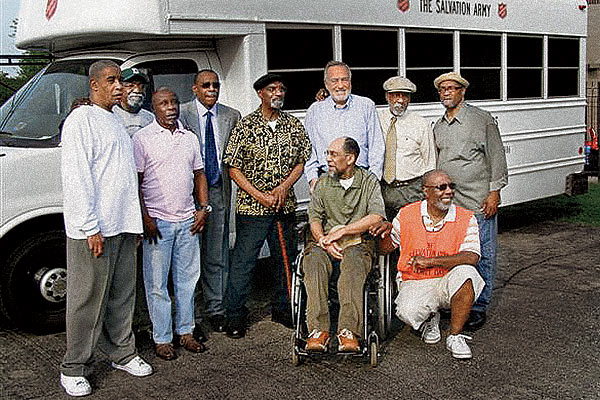
A Foundation Years reunion photo taken in Chicago in May 2011 (from left, back row) Cecil Davis, Allan “Tiny” Evans, Paul Cooper, Michael Orr, Henry Jordan, Paul Rahmeier, C. Siddha Webber, and Henry Crumpton (front row) William Burks and Percy Wiggins
Related:

PHOTO GALLERY »
Meet the students from the street
Not everyone made it. Eddie “Peppilow” or “Pep” Perry, famous throughout the West Side as the founder of the Vice Lords, entered Dartmouth in the fall of 1969. When he headed east, the Chicago Sun-Times ran a story about Perry’s latest exploit. “I’m not going to Dartmouth to be a savior or something for black people,” he was quoted. “I’m going ’cause I want to come back here, Chicago, and have a good life, build a family.” But he never got the hang of Dartmouth academics and dropped out after a little more than a year. “Some people didn’t want to ask for the help that they needed,” says Paul Rahmeier. “They were too proud. That was Pep.”
Ultimately, it wasn’t just the Chicago guys getting the hang of Dartmouth, it was Dartmouth getting the hang of the guys.
C. Siddha Webber also entered in 1969 and had an awful time with John Lincoln. He kept getting Ds, though he was verbally eloquent. (He would later be ordained as a minister and earned a Ph.D. from McCormick Theological Seminary.) Then, at a poetry reading in his second year, he got a hit response to a rap-poem he’d written: “The White Man on the Moon.” The success made Webber a minor campus celebrity, and members of the English department congratulated him. Webber remembers that Lincoln, who has since died, showed some remorse about grading him so hard. “He admitted he had some racial issues,” says Webber, now a musician, preacher, and naprapath with an office in the Loop. “Then he asked me to help him with his reading list.”
If making it at Dartmouth was complicated, making it after Dartmouth wasn’t automatic, either. And those who left without a degree were back on the street where they started—and arguably worse off. “I was a street hustler [before Dartmouth],” says Crumpton, who left without graduating. “And when I came back, I came back awkward. People didn’t see me as the same person who left these streets.” He got involved in drugs, an addiction which he has since kicked. “One of the reasons people gravitate to drugs is disillusionment,” he says. Crumpton doesn’t blame Dartmouth, but it’s hard for him not to see the experience as part of the mix that caused him to waste 37 years before he got clean.
Others didn’t pull out of it. Eddie Perry had died by 1980; after dropping out of Dartmouth, he was weakened by drugs and suffered liver failure. The irony is that in those few years when some of the West Side’s smartest young men were in Hanover, crack and gunplay took over whole swaths of the inner city. Chicago’s biggest gangs (including the Vice Lords and the South Side’s Blackstone Rangers) became intractably violent and, by the early 1970s, ill suited for any experiment like the Foundation Years. Change in the neighborhood, plus the increased expenses connected to the growing contingent of ex–gang leaders, motivated Dartmouth to discontinue the program after 1969 (the last Foundation Years students graduated in 1973). By then, Dartmouth was putting other affirmative action programs into place.
Those who got degrees never made it to the pinnacle of their professions. Henry Jordan graduated from Northwestern Law School, but his heart was not in it, and he did not pass the bar. He had some jobs in law firms, but his friend Cynthia Kobel, a relative of the Montgomery family, which funded the Foundation Years, says Jordan believed he was frequently used as a token black. He preferred to think of himself as an artist, and Kobel says that the most satisfying thing he did was teach art in Cabrini-Green. Today, he struggles with speaking and moving after suffering two strokes.
As for Tiny Evans, after graduation, he started at Dartmouth’s Tuck School of Business because he was eager to earn money. “But they told me that at Tuck they don’t teach you how to make money, they teach you how to manage money.” So he returned to Chicago, where he worked for a while at the accounting firm Peat, Marwick, Mitchell & Co., which he found “square” and boring. Later, he made money selling used cars.
Evans has had many other jobs along the way. He was a case manager in a mental health program on the West Side. During the Harold Washington administration, he organized a program to counsel gang members toward school and away from violence. Midcareer, he earned a master’s degree in education and worked for Chicago Public Schools in a variety of neighborhoods. He retired a year ago but still works with kids at the American Boys Commonwealth youth center, a safe refuge for him when he was growing up in North Lawndale.
What you discern from Evans is that he never really left the street. “My wife says I sleep on the South Side but I live on the West Side,” he says.
He has no regrets. “I did everything I wanted to do,” he says. “I never sold out.” He takes genuine pleasure in his family: kids, grandkids, and one great-grandchild. “I don’t have a lot of money, but I am rich.” Most of his grandchildren are in college or will go. “One of them goes to Cornell,” he notes with particular pride.
“A lot of gang guys tell their kids, ‘Don’t be like me.’ But I went to college. I can say, ‘Be like me.’ See, you can make it in America even if it takes time,” Evans says. “For me, my family, Dartmouth was the start of something, and that’s good.”
Photograph: Courtesy of Paul Rahmeier



Comments are closed.